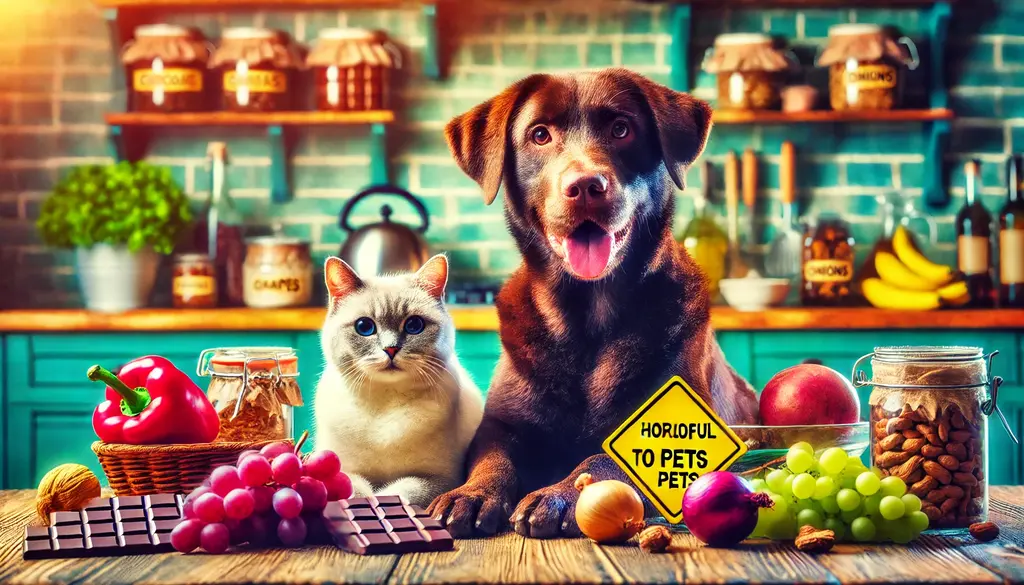Bringing a pet into your home is more than just adding a furry friend to your life—it’s taking on the responsibility of ensuring their safety and well-being at all times. While pet owners are often cautious about things like regular exercise and vaccinations, one crucial area that doesn’t always get the attention it deserves is food safety.
Many common household foods can pose serious health risks to pets, and some can even be fatal. In this article, we will dive deep into some foods you must never bring into your home if you have pets, along with explanations of why they are harmful and how to prevent accidents.
Why are Certain Foods Toxic to Pets?
Pets, particularly dogs and cats, have vastly different digestive systems compared to humans. Their bodies metabolize food differently, and substances that are harmless or even healthy for humans can be extremely dangerous for pets. For instance, compounds like theobromine, found in chocolate, or xylitol, a common artificial sweetener, can cause severe health issues because pets lack the enzymes necessary to process them.
Toxic foods can affect pets in various ways, including causing gastrointestinal upset, organ damage, or neurological problems. Symptoms of food poisoning in pets can range from mild, such as drooling and vomiting, to life-threatening, such as seizures or organ failure. The key to preventing these outcomes is awareness and proper storage of potentially harmful foods.
1. Chocolate: A Deadly Treat
Chocolate is one of the most dangerous foods for pets, particularly dogs. It contains theobromine and caffeine, both of which are toxic to pets. The darker the chocolate, the more theobromine it contains, making baking chocolate and dark chocolate especially hazardous. Even a small amount can cause symptoms such as vomiting, diarrhea, rapid breathing, and seizures. Severe cases can lead to heart failure and death. If you have chocolate in your home, store it securely in high cabinets or sealed containers to prevent accidental ingestion.
2. Grapes and Raisins: Small But Deadly
Grapes and raisins may seem like an innocent snack, but they are highly toxic to dogs. Even small amounts can cause acute kidney failure, which is potentially fatal. The exact toxin in grapes and raisins remains unknown, but symptoms of ingestion often include vomiting, lethargy, and a loss of appetite. In severe cases, dogs may stop urinating altogether, which is a clear sign of kidney failure. Always avoid leaving these fruits within reach and educate guests about the dangers they pose.
3. Onions and Garlic: Hidden Dangers in Everyday Foods
Onions, garlic, and other members of the allium family (such as leeks and chives) are toxic to both dogs and cats. These foods contain thiosulfates, which can damage red blood cells and lead to anemia. The symptoms of onion or garlic poisoning may not appear immediately but can include weakness, pale gums, and increased heart rate. Since these ingredients are commonly found in many dishes, it’s important to keep leftovers and food scraps out of your pet’s reach.
4. Avocado: Not So Super for Pets
Avocados are often touted as a superfood for humans, but they’re far from super for pets. They contain persin, a compound that can cause vomiting, diarrhea, and heart congestion in dogs and cats. While the flesh of the avocado contains lower levels of persin, the pit and skin are particularly dangerous. Birds and small animals are even more sensitive to avocado toxicity, making it crucial to keep this fruit out of reach from all pets.
5. Macadamia Nuts: Harmful Even in Small Quantities
Macadamia nuts are another highly toxic food for dogs. Symptoms of macadamia poisoning include weakness, vomiting, tremors, and hyperthermia, usually appearing within 12 hours of ingestion. Even a small amount of these nuts can cause adverse effects, so it’s best to keep them out of your pet’s environment entirely. If you enjoy macadamia nuts as a snack, be diligent about cleaning up crumbs or leftovers.
6. Alcohol: No Excuse for Sharing
Alcohol consumption is dangerous for pets, even in tiny amounts. Pets can suffer from ethanol poisoning, which affects their central nervous system. Symptoms include vomiting, difficulty breathing, disorientation, and, in severe cases, coma or death. Alcohol isn’t just found in beverages; it can also be present in desserts, sauces, and fermented foods. Always dispose of alcoholic products responsibly and keep them out of your pet’s reach.
7. Caffeine: Energy for You, Danger for Them
Caffeinated beverages and foods, including coffee, tea, energy drinks, and certain sodas, are dangerous for pets. Caffeine contains methylxanthines, which can cause restlessness, rapid breathing, heart palpitations, muscle tremors, and seizures. Even coffee grounds or tea bags can pose a risk. Make sure these items are stored securely and clean up any spills promptly.
8. Xylitol: A Silent Killer
Xylitol is a sugar substitute commonly found in sugar-free gum, candies, baked goods, and even some peanut butter brands. For dogs, xylitol is extremely toxic and can cause a rapid insulin release, leading to hypoglycemia (low blood sugar). Symptoms of xylitol poisoning include vomiting, loss of coordination, and seizures. In severe cases, it can lead to liver failure. Always check labels for xylitol and avoid giving your pets human foods containing this ingredient.
9. Yeast Dough: More Than Just Discomfort
Unbaked yeast dough can be dangerous for pets because it continues to rise in their stomachs after ingestion. This can cause painful bloating and potentially life-threatening stomach rupture. Additionally, the fermentation process produces ethanol, leading to alcohol poisoning. If you’re baking, ensure your pet doesn’t have access to raw dough, and clean up any spills immediately.
10. Bones from Table Scraps: A Hidden Hazard
Feeding your pets bones from table scraps might seem like a natural treat, but it’s anything but safe. Cooked bones can splinter easily, causing blockages, choking, or tears in the digestive tract. Even raw bones carry risks of bacterial contamination. Instead, provide your pets with veterinarian-approved chew toys or specially designed-pet treats.
11. Raw Eggs: A Risky Gamble
Raw eggs carry the risk of Salmonella and E. coli, which can cause severe gastrointestinal distress in pets. Additionally, raw eggs contain avidin, a protein that interferes with biotin absorption, potentially leading to skin and coat issues. If you want to give your pet eggs as a treat, ensure they are cooked thoroughly.
12. Salt and Salty Snacks: A Recipe for Dehydration
Excess salt can lead to sodium ion poisoning in pets. Symptoms include vomiting, diarrhea, tremors, seizures, and, in extreme cases, death. Salty snacks like chips, pretzels, and popcorn should never be given to pets. Always ensure your pet has access to plenty of fresh water, especially if they’ve consumed something salty by accident.
13. Mushrooms: A Foraging Hazard
Wild mushrooms can be incredibly toxic to pets, causing symptoms like abdominal pain, drooling, liver damage, and even death. Because it can be difficult to distinguish safe mushrooms from toxic ones, it’s best to keep your pets away from all mushrooms. Even store-bought varieties should be off-limits.
14. Fat Trimmings and Greasy Foods: Too Rich for Pets
Feeding your pets fat trimmings or greasy leftovers may seem harmless, but these can lead to pancreatitis. This condition causes inflammation of the pancreas and is marked by symptoms like abdominal pain, vomiting, and lethargy. To avoid such issues, stick to pet-appropriate foods and avoid feeding them scraps from the table.
15. Rhubarb Leaves: A Garden Danger
Rhubarb leaves contain oxalates, which can affect your pet’s nervous system, kidneys, and digestive tract. Symptoms include drooling, tremors, and kidney failure. If you grow rhubarb in your garden, ensure your pets cannot access the plants. Even small amounts of rhubarb leaves can be dangerous.
How to Practice Food Safety at Home?
Keeping harmful foods away from your pets is an essential part of responsible pet ownership. Always store food securely in cabinets or refrigerators, and never leave food unattended on countertops or tables. Educate everyone in your household, including children and guests, about the dangers of sharing human food with pets. When in doubt, consult with your veterinarian to determine what foods are safe to share.
What to Do in Case of Accidental Ingestion?
If your pet accidentally ingests a toxic food, time is of the essence. The first step is to remain calm and act quickly. Gather as much information as possible about what your pet ate, how much, and when it occurred. This information will be critical for your veterinarian or an animal poison control center. Do not attempt to induce vomiting unless explicitly instructed to do so by a professional, as this can sometimes make the situation worse.
Contact your veterinarian immediately or call a pet poison helpline, such as the ASPCA Animal Poison Control Center or the Pet Poison Helpline. Be prepared to describe your pet’s symptoms, the food consumed, and your pet’s weight and breed. Keep the packaging or food label handy, as it may contain information about ingredients or toxins.
In cases of severe symptoms such as seizures, difficulty breathing, or loss of consciousness, transport your pet to an emergency veterinary clinic immediately. If possible, call ahead to let them know you’re coming so they can prepare for your arrival.
You may also like this: The Basics of Roof Safety
Proactive Measures for Pet Safety
Preventing accidental ingestion is the best way to keep your pets safe. Here are some proactive measures you can take to minimize risks:
- Secure Storage: Always store food and harmful substances in high, locked cabinets or containers with secure lids. Avoid leaving food out on countertops or tables, especially unattended.
- Trash Control: Use pet-proof trash cans or ensure your garbage is kept in a place your pet cannot access. Curious pets can rummage through the trash and find harmful scraps.
- Pet-Free Kitchen Zones: Establish pet-free zones in your kitchen or dining area to reduce the chance of your pets coming into contact with harmful foods during meal prep or eating.
- Educate Your Household: Inform everyone in your home, including guests, about the dangers of feeding human food to pets. Many people are unaware of how harmful certain foods can be.
- Provide Alternatives: Keep pet-safe treats available to satisfy your pet’s curiosity or appetite without putting them at risk. Carrot sticks, apple slices (without seeds), or specially formulated pet treats are excellent choices.
- Monitor Your Pet: Be vigilant about your pet’s activities, especially during gatherings or parties where food is more accessible. Supervision can prevent a dangerous situation before it happens.
Conclusion
As a pet owner, it’s your responsibility to ensure that your furry companions are safe from household hazards, including toxic foods. The list of foods to avoid might seem overwhelming at first, but with a little diligence and awareness, you can create a home environment where your pets can thrive.
Remember, pets rely on us to make the right decisions for their health and safety. By following the guidelines in this article, educating others, and consulting with your veterinarian when in doubt, you can prevent the heartbreak of accidental poisoning and enjoy many happy, healthy years with your beloved pets.
Share this information with fellow pet owners to spread awareness. Together, we can ensure that every home is a safe haven for the pets we love so dearly.


